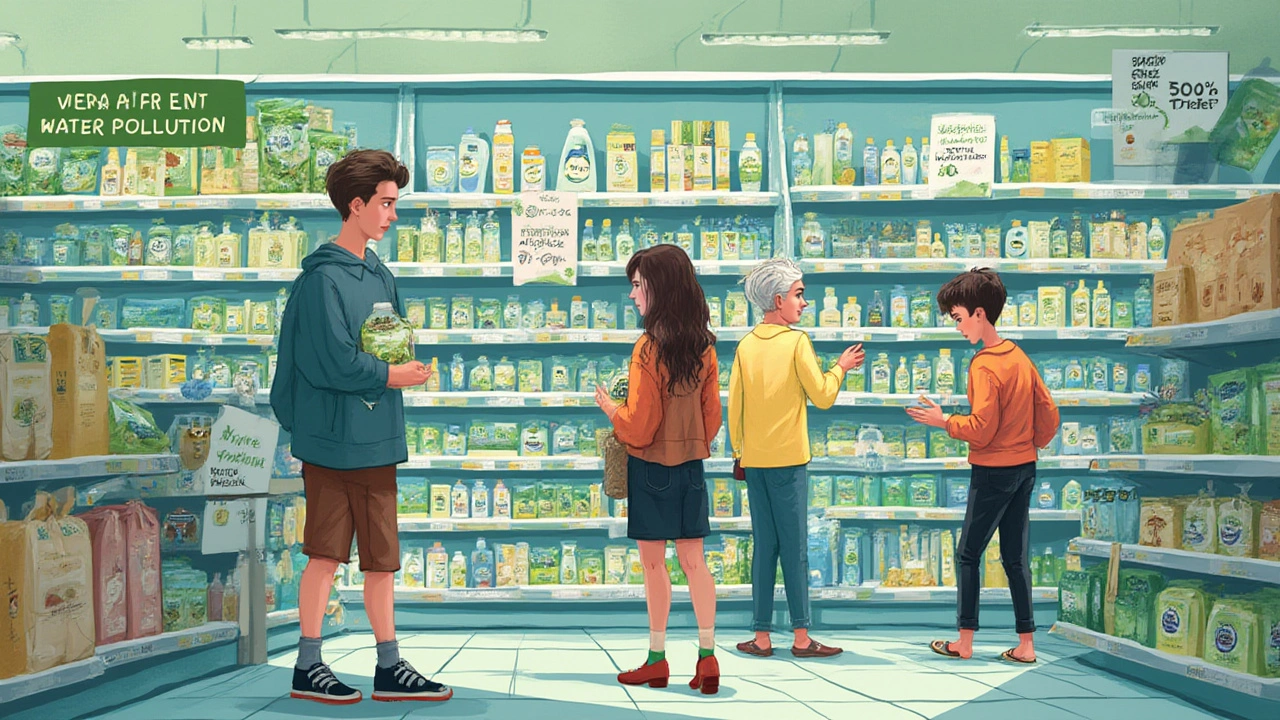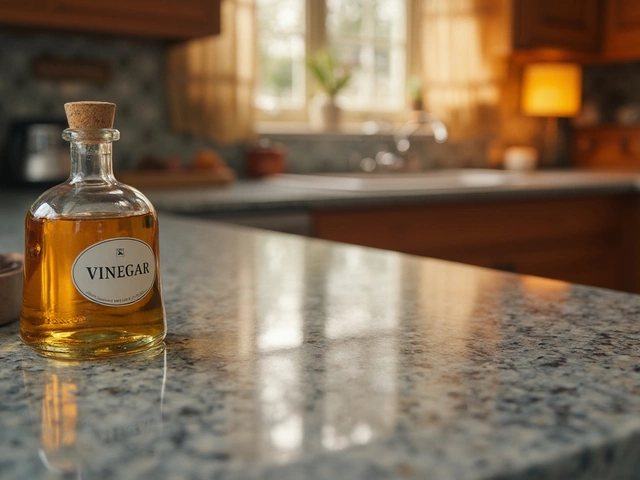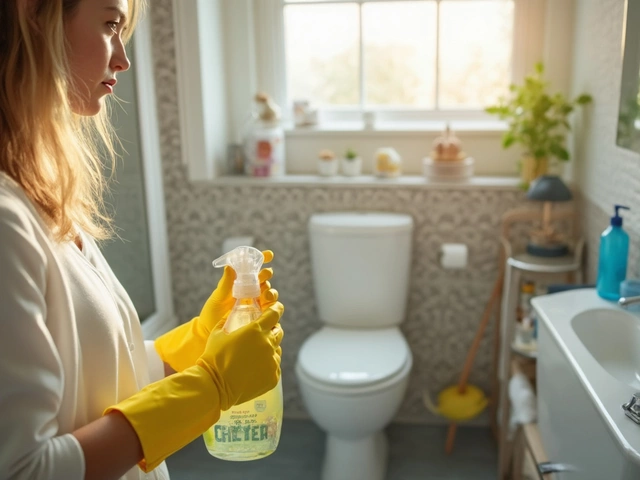Pop quiz: which daily household product pours 35 billion loads of chemicals into U.S. waterways every year? Laundry detergent. The pile of slick marketing and plastic jugs lining supermarket shelves hides a messy truth—most laundry soaps are loaded with petroleum, phosphates, and synthetic fragrances. Even the ones with pictures of green leaves and fresh mountain springs. There’s nothing clean about that.
How Laundry Detergent Affects the Environment
After each wash, what’s left in the drum doesn’t just disappear: it travels through pipes and ends up in local rivers, lakes, and oceans. Standard detergents usually rely on phosphates, optical brighteners, and surfactants derived from fossil fuels. These pesky molecules don’t always break down in water, so they stick around, fuel algae blooms, and choke aquatic life. In fact, studies show phosphorus runoff—much of it from household products—causes huge dead zones in bodies of water, including the Gulf of Mexico.
Let’s break down what actually happens. The key environment offenders are:
- Phosphates: Used to soften water, but feed harmful algae in waterways, which suffocates fish and blocks sunlight for other plants.
- Petroleum-based surfactants: These help your clothes get clean, but they hang around in water for ages and break down into compounds toxic to marine life.
- Optical brighteners: Basically fake whiteners that accumulate in wildlife tissue and act as irritants for people, too.
- Synthetic fragrances: “Fresh linen” or tropical rain?” That usually means phthalates, which can build up in our bodies and harm hormone systems in people and animals alike.
The scale is jaw-dropping. According to the Environmental Protection Agency (EPA), Americans go through around 700 million plastic laundry detergent jugs annually. Most of that plastic isn’t recycled. A recent study published in the journal Science Advances revealed only 9% of all plastics are actually recycled, with the rest ending up in landfills, oceans, and even drifting as microplastics into our drinking water. The consequences ripple out long after the spin cycle ends.
Traditional detergents also gobble up piles of energy and water during production. One MIT report showed that making one kilogram of standard laundry detergent releases about 3 to 4.6 kilograms of greenhouse gases—roughly equivalent to driving a gas-powered car 10 miles. Depending on where and how your detergent is produced and shipped, the toll on the planet stacks up fast.
What Makes an Eco-Friendly Detergent?
If your first thought is, "Isn’t greenwashing a thing?" Yes, it really is. A brand can slap a leafy logo and earthy colors on the front, but plenty still pack their product with the same old synthetics and sell it in virgin plastic jugs. Here’s what actually counts:
- Biodegradable ingredients: These break down naturally in soil and water, so they don’t come back to haunt you (or the trout) weeks later.
- Plant-based surfactants: Derived from coconut, corn, or other renewable resources, these do the heavy lifting—without becoming environmental ghosts.
- Phosphate- and chlorine-free: No more fueling killer algae storms or chemical soup in local rivers.
- Fragrance transparency: If there’s a scent, the best brands spell out every plant oil or ingredient they use—nothing mysterious.
- Minimal, recyclable, or plastic-free packaging: Powder in cardboard? Detergent sheets in compostable envelopes? Those beat big plastic jugs every time.
If you want the hard data, see how a few top eco-brands stack up in this real-world table:
| Brand | Main Ingredients | Packaging | Certifications | Phosphate-Free | Biodegradable |
|---|---|---|---|---|---|
| ECOS | Coconut-based surfactants, baking soda | Recycled plastic | EPA Safer Choice, Leaping Bunny | Yes | Yes |
| Seventh Generation | Plant-based surfactants, enzymes | Recycled plastic | B Corp, USDA Biobased | Yes | Yes |
| Tru Earth | Plant-derived cleaning agents | Compostable envelope | Leaping Bunny, Paraben-free | Yes | Yes |
| Dropps | Mild surfactants, mineral salt | Compostable cardboard | EPA Safer Choice | Yes | Yes |
Look for labels like “USDA Certified Biobased,” “EPA Safer Choice,” and “Leaping Bunny” (no animal testing). These mean third-party experts have looked into the ingredients and practices, not just the marketing team.

Top Picks for the Most Environmentally Friendly Laundry Detergent
When my wife Mara tried to replace our old detergent with something less dicey, it took some trial and error. Honestly, some so-called green detergents left our clothes smelling weird or looking dingy. But there are a few that cleaned just as well as the big brands—without the pollution punch.
- Dropps: These are laundry pods, but without the plastic shell—just plant-based cleansers wrapped in water-soluble film. You get them in a recycled paper box. Dropps scored high in independent cleaning tests (Consumer Reports, 2024), and our towels smell like nothing but clean fabric.
- Tru Earth: These are ultra-lightweight sheets you toss right in the drum. They dissolve instantly, clean well, and seriously cut down on packaging waste. Plus, a year’s supply fits in a shoebox.
- ECOS Liquid: Made with coconut-based surfactants and available in huge refill containers to minimize packaging. It’s super gentle but handled my muddy hiking socks just fine. They’re family-owned and their plant runs on renewable energy.
- Meliora Powder: Their formula is baking soda-heavy and comes in a steel canister—that means no plastic, ever. It has only a few ingredients, all clearly listed. It’s good for sensitive skin (which matters if you have little kids or allergies at home).
- Seventh Generation: Probably the biggest-name eco brand out there, with multiple certifications and a good, reliable clean. They use recycled packaging, too.
Each of these options ditches harsh synthetics and reduces plastic. One thing to watch for: some detergent pods and sheets from less-reputable brands still wrap their products in polyvinyl alcohol (PVA), which recent research shows might not biodegrade completely in all wastewater systems. When in doubt, go for cardboard or steel packaging and brands with ingredient transparency.
Your results may vary—soil, water hardness, and laundry habits all matter. Sometimes, using a bit less detergent, or washing in cold, makes a bigger difference than constantly switching brands. My advice: pick one green option, use it consistently, and stick to the basics (don’t dump in half a cup if a tablespoon will clean the load).
Tips for Greener Laundry Routines
Switching your soap is only the beginning. There’s a lot more you can do to cut your laundry-related footprint down to size.
- Wash in cold water: This one’s huge. Heating water eats up to 90% of the energy per load! Unless your clothes are covered in oil or sick germs, cold water works just as well with today’s detergents.
- Do full loads (not overloaded): Wait until you actually have a big pile. Fewer loads means less water, soap, and electricity.
- Skip the extra rinse: Modern washers usually handle the soap in one cycle. Extra rinses just waste water and energy unless you’re washing diapers or sensitive skin stuff.
- Air dry when you can: Dryers account for almost 6% of the average household’s total energy use, according to the U.S. Department of Energy. String up a drying rack inside or hang stuff on the line when possible.
- Try laundry balls or magnets: While studies are mixed, some folks swear by wool dryer balls for speeding up drying and softening clothes—another way to skip fabric softener (which is bad news for the planet, anyway).
- Make your own stain remover: Baking soda and vinegar can fix most stains without the need for harsh bleaches.
- Reuse greywater: In places where it’s legal, rerouting laundry water to your garden can be a win—especially if you use a truly biodegradable detergent.
I didn’t start out as a detergent label reader, but after learning just how much of my daily routine left a mark, I couldn’t unsee it. These days, reaching for a powder in a cardboard box instead of a garish blue plastic jug feels like a little victory for the river a few miles from where my kids play every summer. One harmless choice, multiplied by millions of households, really does move the needle. And with better options on the shelf—and a few tweaks to our daily habits—doing the right thing is actually pretty easy.




